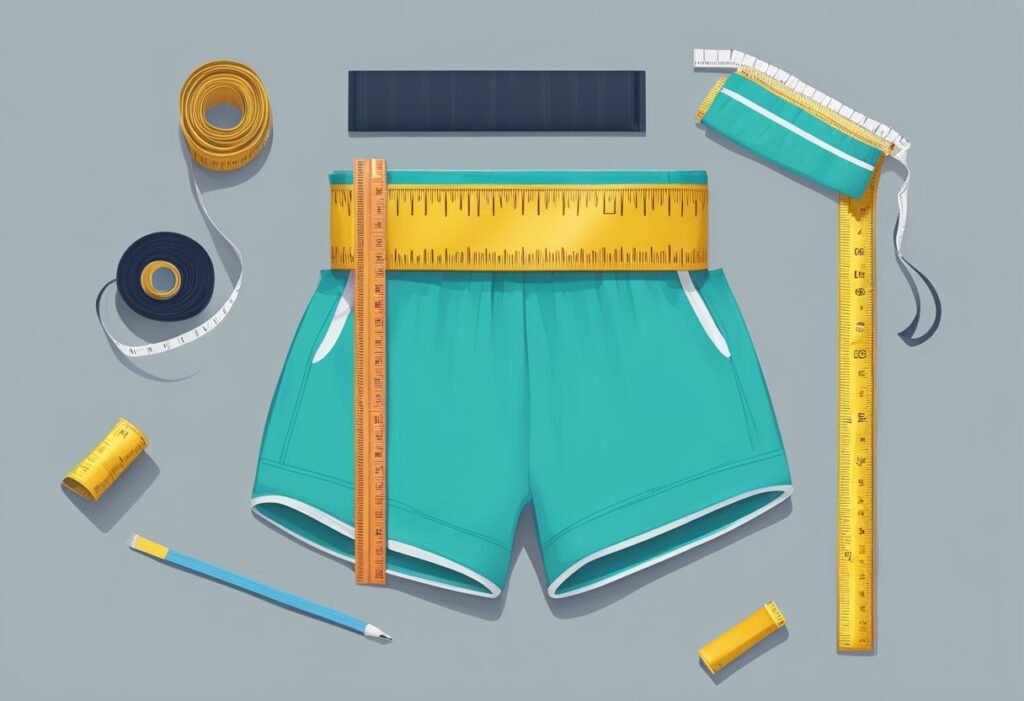How to Choose the Right Size of Running Shorts
Choosing the right size of running shorts can be a daunting task, especially for those who are new to running or have never purchased running shorts before. However, selecting the right size is crucial for a comfortable and enjoyable running experience. Ill-fitting shorts can cause chafing, discomfort, and even hinder performance.
The first step in choosing the right size of running shorts is to determine your correct size. This can be done by measuring your waist and hips, as well as referring to the sizing chart provided by the manufacturer. It is important to keep in mind that different brands may have slightly different sizing, so it is always best to refer to the specific brand’s sizing chart. Additionally, it is important to try on different sizes and styles to find the best fit for your body type.
When choosing running shorts, it is also important to consider the length and style. Some runners prefer shorter shorts for increased mobility, while others prefer longer shorts for more coverage and support. It is also important to consider the fabric and features, such as moisture-wicking technology and pockets. By taking these factors into consideration, runners can choose the right size and style of running shorts for their individual needs and preferences.
Understanding Running Shorts Sizes
When it comes to choosing the right size of running shorts, it is important to understand the sizing options available. Running shorts come in a variety of sizes and styles, and finding the right fit can make all the difference in your comfort and performance.
Men’s Sizing
Men’s running shorts typically come in waist sizes, which can range from small to extra-large. It is important to measure your waist correctly to ensure you choose the right size. To measure your waist, use a tape measure to wrap around your natural waistline, which is typically located just above your belly button.
In addition to waist sizes, some men’s running shorts may also come in inseam lengths, which can range from 3 inches to 9 inches. The inseam length refers to the length of the shorts from the crotch to the hem.
Women’s Sizing
Women’s running shorts often come in sizes that are based on hip measurements, which can range from extra small to extra-large. To measure your hips correctly, use a tape measure to wrap around the fullest part of your hips.
Like men’s running shorts, women’s shorts may also come in inseam lengths, which can range from 2 inches to 7 inches. The inseam length refers to the length of the shorts from the crotch to the hem.
When choosing the right size of running shorts, it is important to consider the fit you prefer. Some runners prefer a loose fit, while others prefer a more snug fit. It is also important to consider the type of running you will be doing, as some styles may be better suited for certain activities.
Overall, understanding the sizing options available for running shorts and taking accurate measurements can help you choose the right size for your needs.
Factors to Consider When Choosing Running Shorts
When it comes to choosing the right size of running shorts, there are several factors that one must consider. This section will discuss some of the most important factors that can help you make an informed decision.
Material and Fabric
The material and fabric of running shorts are crucial factors that can affect your comfort and performance during a run. It is important to choose shorts that are made from breathable and moisture-wicking materials, such as polyester or nylon. These types of fabrics can help keep you cool and dry, preventing chafing and irritation.
Shorts Length
The length of running shorts is another important factor to consider. Some runners prefer shorter shorts that allow for more freedom of movement, while others prefer longer shorts that provide more coverage and support. It is important to choose shorts that fit your personal preferences and needs.
Waistband and Fit
The waistband and fit of running shorts are also important considerations. A good waistband should be snug but not too tight, and it should stay in place during your run. The fit of the shorts should be comfortable and allow for a full range of motion. It is important to try on different sizes and styles of shorts to find the best fit for your body type.
By considering these important factors, you can choose the right size of running shorts that will help you stay comfortable and perform at your best during your runs.
How to Measure Yourself for the Perfect Fit
When it comes to choosing the right size of running shorts, measuring yourself is crucial to ensure a comfortable fit. Here are the three key measurements you need to take:
Measuring Your Waist
To measure your waist, wrap a measuring tape around the narrowest part of your torso, which is usually just above your belly button. Make sure the tape is snug but not too tight, and keep it parallel to the ground. Note down the measurement in inches or centimeters.
Measuring Your Hips
To measure your hips, wrap the tape around the widest part of your hips and buttocks. This is usually about 7-9 inches (18-23 cm) below your waist. Again, keep the tape snug but not too tight, and make sure it’s parallel to the ground. Note down the measurement in inches or centimeters.
Inseam Length
The inseam length is the distance from your crotch to the bottom of your shorts. To measure it, stand up straight with your legs shoulder-width apart. Place the end of the measuring tape at the top of your inner thigh, near your crotch. Measure down the inside of your leg to the bottom of your shorts. Note down the measurement in inches or centimeters.
Once you have these measurements, you can consult the size chart provided by the manufacturer of the running shorts you’re interested in. Keep in mind that different brands may have slightly different sizing, so it’s always a good idea to check the specific size chart for the brand you’re considering.
By taking the time to measure yourself properly, you can ensure that you choose the right size of running shorts for your body type. This will not only make your runs more comfortable, but it can also help prevent chafing and other discomforts that can arise from ill-fitting shorts.
Trying on Running Shorts
When it comes to choosing the right size of running shorts, trying them on is essential. This will help ensure that the shorts fit properly and provide the necessary comfort and mobility during a run. Here are some tips for trying on running shorts:
Checking for Comfort and Mobility
The first thing to consider when trying on running shorts is comfort. The shorts should feel comfortable around the waist, hips, and thighs. They should not be too tight or too loose. The waistband should sit comfortably on the waist without digging in or sliding down. The shorts should also allow for a full range of motion during running.
To check for mobility, try doing some lunges or squats in the shorts. This will help determine if the shorts are too tight or restrictive. If the shorts feel uncomfortable or restrict movement, it may be necessary to try a different size or style.
Testing Shorts in Motion
In addition to checking for comfort and mobility while standing, it’s important to test the shorts in motion. Take a few strides or jog in place to see how the shorts feel while running. They should not ride up or chafe during movement.
It’s also important to consider the length of the shorts. Some runners prefer shorter shorts for more freedom of movement, while others prefer longer shorts for more coverage. Try on different lengths to determine what feels most comfortable and practical for your running needs.
Overall, trying on running shorts is an important step in choosing the right size and style. By checking for comfort, mobility, and practicality, runners can find shorts that will enhance their running experience.
Care and Maintenance of Running Shorts
Choosing the right size of running shorts is important, but so is taking care of them to ensure they last as long as possible. Here are some tips for caring and maintaining your running shorts:
Washing
It is important to wash your running shorts after each use to remove sweat and bacteria that can cause odor and damage to the fabric. Follow the care instructions on the label, but generally, it is recommended to wash them in cold water and avoid using fabric softeners or bleach. Hang them to dry instead of using a dryer to prevent shrinkage and damage to the elastic waistband.
Storage
Store your running shorts in a cool, dry place away from direct sunlight. Avoid folding them too tightly or leaving them crumpled up, as this can cause creases and damage to the fabric. Hanging them up is a good option, but make sure to use a hanger with clips to avoid leaving marks on the fabric.
Maintenance
Inspect your running shorts regularly for any signs of damage, such as loose threads or holes. Repair any damage as soon as possible to prevent it from getting worse. If the elastic waistband starts to lose its stretch, consider replacing it instead of continuing to wear the shorts, as this can cause them to slip down during a run.
By following these care and maintenance tips, you can help ensure that your running shorts last longer and continue to provide the comfort and support you need during your workouts.
Also See Below posts:
- Purdue University Scholarship 2024-25 in USA (Funded)
- University of Alberta Scholarships 2024-25 in Canada (Fully Funded)
- Finland Scholarships Without IELTS 2024 | Free Study in Finland
- WHO Free Online Courses 2024-2025 with Free Certificates
- What are the best materials for moisture-wicking running shorts
- How can I choose the right size of running shorts
- What are some creative ways to layer with fashion shorts in cooler weather
- What shoes and accessories complement fashion shorts outfits
- How do I choose the right fabric and texture for fashion shorts
- How can I find the perfect fit when shopping for fashion shorts
- What are some tips for incorporating fashion shorts into my everyday wardrobe
- How do I find running shorts with adequate pockets for carrying essentials
- How can I create a flattering silhouette with fashion shorts?
- How can I style fashion shorts for different occasions
- What are the benefits of UV protection in outdoor shorts
- What is the ideal length for running shorts


